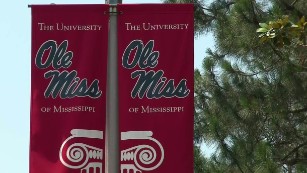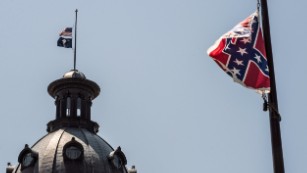Ole Miss removes state flag from campus
Updated 2:23 PM ET, Mon October 26, 2015
(CNN)The University of Mississippi has removed the state flag from campus, according to a university statement issued Monday.
The move comes after student senators voted 33-15 with one abstention
last week to ask the school administration to furl the banner, which
includes the Confederate battle emblem in its upper left corner.
"University
of Mississippi Police Department officers lowered and furled the state
flag in a Lyceum Circle ceremony as the campus opened Monday morning," a
school statement said. "The flag will be preserved in the University
Archives along with resolutions from students, faculty and staff calling
for its removal."
Like many students
and observers, Buka Okoye, president of the school's NAACP chapter, had
the impression that the school wouldn't act on the student senators'
vote until a new chancellor was appointed. The NAACP was in the process
of organizing a march in two weeks to pressure the university
administration to take down the flag immediately. He was "shocked" to
learn the school had removed the banner Monday, he said.
"It
was huge that the university came on the right side," he said. "That
was huge for me. It really shows me how much the university has
progressed."
He
is proud that his school has sent the message that it wants to
"distance itself from Confederate iconography in general," and while it
certainly doesn't mean the end of racism, it's another step in taking
down the structures that support racism, he said.
The
next step for him and the NAACP chapter is to pressure the university
to do something about the obelisk honoring "Confederate dead" that is
located in the area of campus known as The Circle, where the state flag
flew. The monument has been there since 1906.
Elation, disappointment
Allen
Coon, a student senator and president of the College Democrats who was
at the forefront of the fight to take down the flag, told CNN he, too,
was surprised and elated by the decision.
"They
didn't announce anything. They did it early this morning," he said.
"The leadership acted swiftly, and despite the opposition from the
governor, who two days ago said college students act emotionally, they
took it down. It's exciting."
Another student senator, Andrew Soper, who organized a petition
that drew more than 1,800 signatures (at least 1,500 of which came on
the day of the vote or after the vote) urging Ole Miss to keep the flag
on campus, said he was disappointed to see the flag taken down.
"I
think it's the wrong move. They should have done it through the state
of Mississippi. They didn't do it the right way," he said.
'A flag that speaks to who we are'
Interim
Chancellor Morris Stocks, who called for the state to change its flag
in June, applauded the civility with which student senators came to
their decision, saying, "Their respect for each other, despite genuine
differences of opinion, was an inspiration to us all."
"I
understand the flag represents tradition and honor to some. But to
others, the flag means that some members of the Ole Miss family are not
welcomed or valued," he said."Our state needs a flag that speaks to who
we are. It should represent the wonderful attributes about our state
that unite us, not those that still divide us."
Confederate tributes have come under increased scrutiny
in the South since the killings of nine African-Americans at Emanuel
African Methodist Episcopal Church in Charleston, South Carolina, in
June. Shooter Dylann Roof apparently revered the flag as a symbol of
white supremacy.
In that state, the
Confederate banner that flew on the Capitol grounds in Columbia was
taken down on July 10, less than a month after the shootings.
Many Mississippi cities furl the flag; some keep it flying
The vote by the Ole Miss student senators follows a decision by aldermen in Oxford, where Ole Miss is located, to remove the flag from city property
in August. That was around the same time actor Morgan Freeman, author
John Grisham, musician Jimmy Buffett and others signed a letter calling on the state to come up with a new flag.
Other Mississippi cities -- including Macon, Columbus, Grenada, Magnolia, Hattiesburg, Clarksdale, Starkville, Yazoo City and Greenwood
-- have voted or issued executive orders to remove the state flag from
city property since the Charleston shooting. (Conversely, the cities of Petal and Gautier have voted since the massacre to keep the flag flying.)
The
City Council in the state capital, Jackson, which hasn't flown the
state flag on city property in more than a decade, voted in July to urge
the state to create a new flag, CNN affiliate WAPT reported.
Also taking action since Charleston were Leflore County, which took down the flag this summer, and the Gulf Coast Business Council and Mississippi Gulf Coast Chamber of Commerce, both of which said they'd endorse a new flag without the Confederate canton in the corner.
The
Ole Miss vote is also in line with the stances of three other public
state universities that don't fly the flag on their campuses: Jackson
State University, Mississippi Valley State University and Alcorn State
University.
Mississippi State University's Faculty Senate voted before a 2001 statewide referendum to support efforts to change the state flag. Delta State University and the University of Southern Mississippi, too, have issued statements calling on the state to redesign the banner.
The
Mississippi University for Women is the only state university that has
not issued a statement or removed the flag, but an article last month in the school's weekly newspaper reported that faculty and school leaders are discussing the matter.
The issue of changing the flag was last brought before the state's voters 14 years ago, when Mississippians chose, by a ratio of nearly 2 to 1, to leave it as is.

















